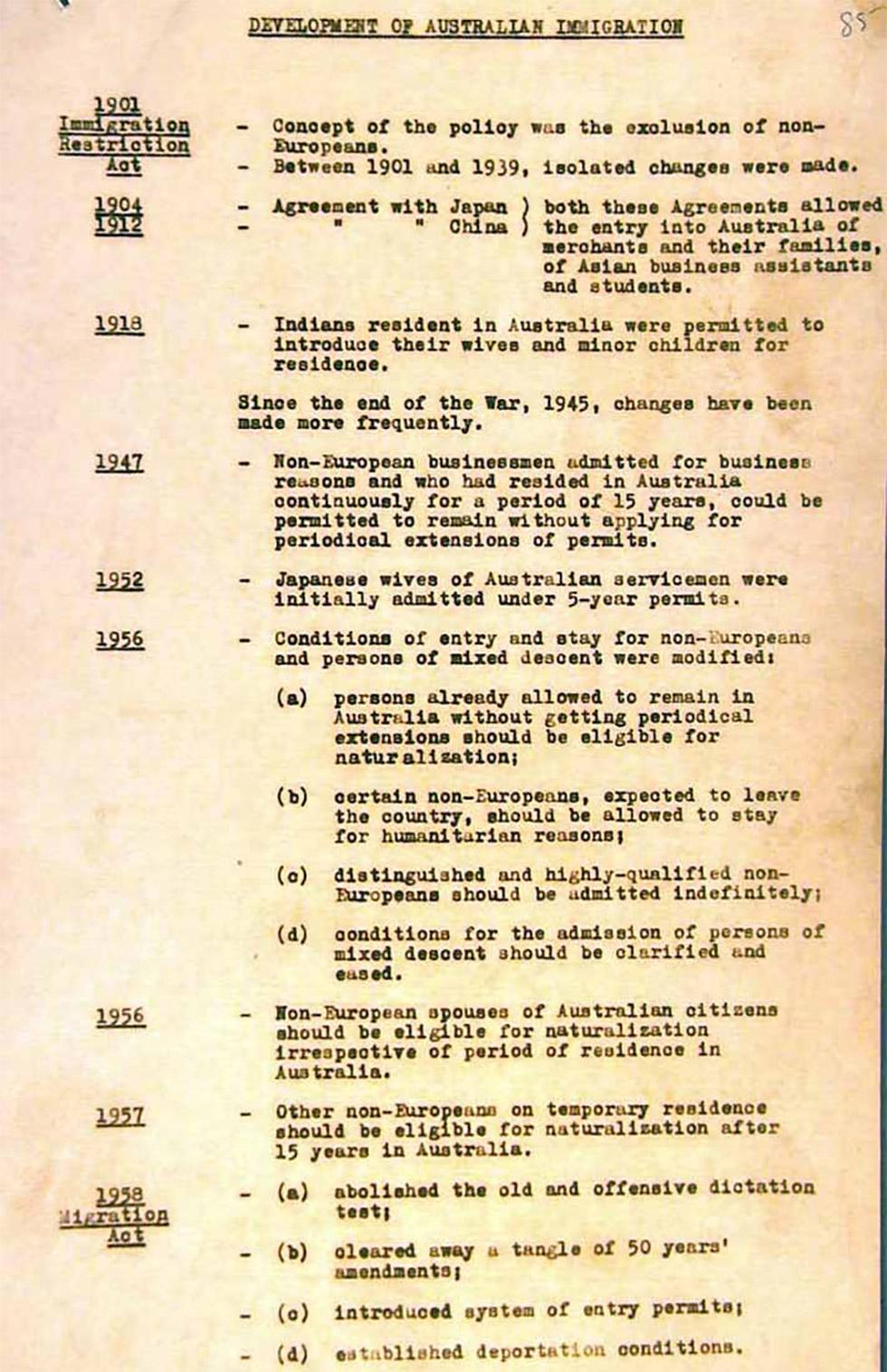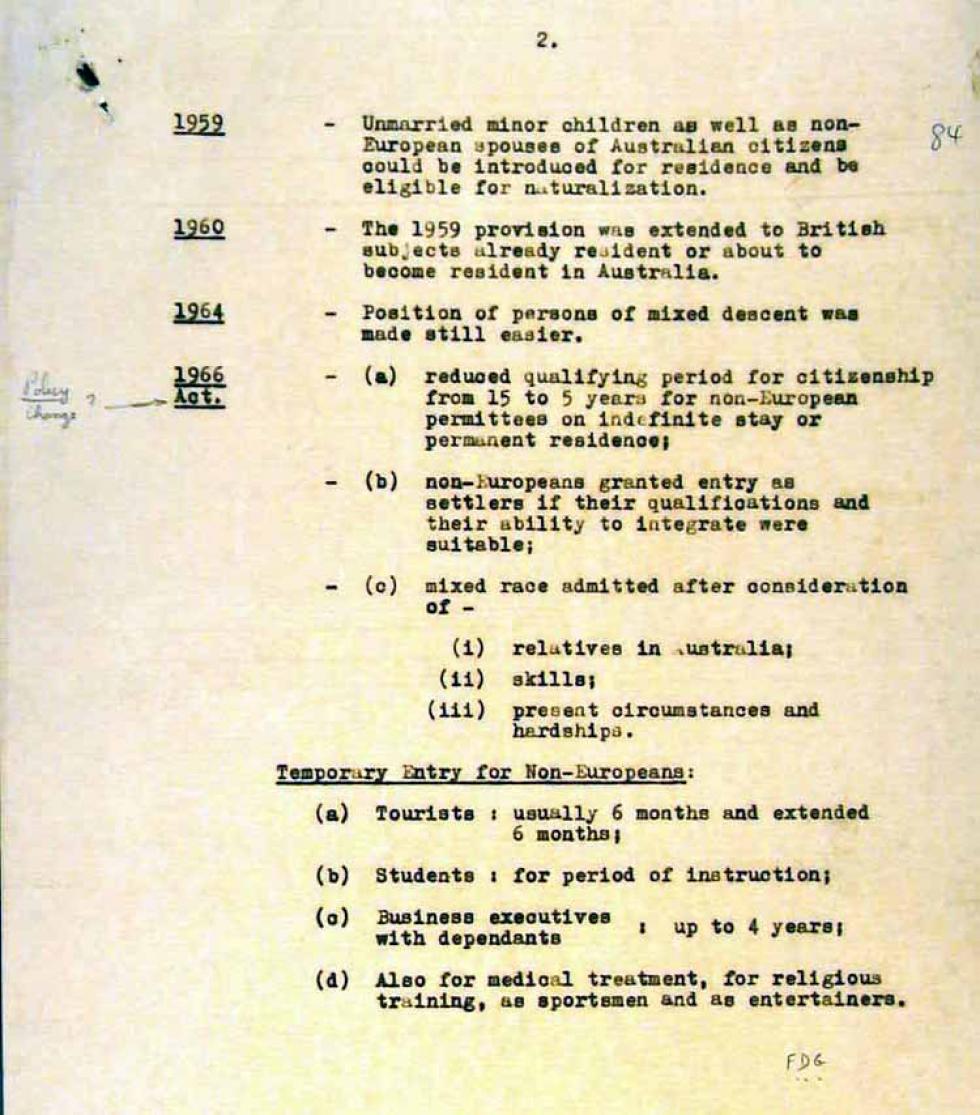

Aboriginal and Torres Strait Islander people should be aware that the National Archives' website and collection contain the names, images and voices of people who have died.
Some records include terms and views that are not appropriate today. They reflect the period in which they were created and are not the views of the National Archives.



DEVELOPMENT OF AUSTRALIAN IMMIGRATION [underlined.]
1901 Immigration Restriction Act [underlined.]
- Concept of the policy was the exclusion of non-Europeans.
- Between 1901 and 1939, isolated changes were made.
1904 [underlined.]
1912 [underlined.]
- Agreement with Japan
- " " [Agreement with] China
both these agreements allowed the entry into Australia of merchants and their families, of Asian business assistants and students.
1918 [underlined.]
- Indians resident in Australia were permitted to introduce their wives and minor children for residence.
Since the end of the War, 1945, changes have been made more frequently.
1947 [underlined.]
- Non-European businessmen admitted for business reasons and who had resided in Australia continuously for a period of 15 years, could be permitted to remain without applying for periodical extensions of permits.
1952 [underlined.]
- Japanese wives of Australian servicemen were initially admitted under 5-year permits.
1956 [underlined.]
- Conditions of entry and stay for non-Europeans and persons of mixed descent were modified:
(a) persons already allowed to remain in Australia without getting periodical extensions should be eligible for naturalisation;
(b) certain non-Europeans, expected to leave the country, should be allowed to stay for humanitarian reasons;
(c) distinguished and highly-qualified non-Europeans should be admitted indefinitely;
(d) conditions for the admission of persons of mixed descent should be clarified and eased.
1956 [underlined.]
- Non-European spouses of Australian citizens should be eligible for naturalization irrespective of period of residence in Australia.
1957 [underlined.]
- Other non-Europeans on temporary residence should be eligible for naturalization after 15 years in Australia.
1958 Migration Act [underlined.]
- (a) abolished the old and offensive dictation test;
- (b) cleared away a tangle of 50 years' amendments;
- (c) introduced system of entry permits;
- (d) established deportation conditions.
[Page] 2.
1959 [underlined.]
- Unmarried minor children as well as non-European spouses of Australian citizens could be introduced for residence and be eligible for naturalization. [Handwritten at right margin; '84'.]
1960 [underlined.]
- The 1959 provision was extended to British subjects already resident or about to become resident in Australia.
1964 [underlined.]
- Position of persons of mixed descent was made still easier.
1966 Act. [underlined.] [Handwritten note in left margin with an arrow drawn to the word 'Act.' reads; 'Policy [word underlined] change?'.]
- (a) reduced qualifying period for citizenship from 15 to 5 years for non-European permittees on indefinite stay or permanent residence;
- (b) non-Europeans granted entry as settlers if their qualifications and their ability to integrate were suitable;
- (c) mixed race admitted after consideration of –
(i) relatives in Australia;
(ii) skills;
(iii) present circumstances and hardships.
Temporary Entry for Non-Europeans: [underlined.]
(a) Tourists: usually 6 months and extended 6 months;
(b) Students: for period of instruction;
(c) Business executives with dependants: up to 4 years;
(d) Also for medical treatment, for religious training, as sportsmen and as entertainers.
[handwritten note, possibly initials, reads: 'FDG'.]
Learn how to interpret primary sources, use our collection and more.
